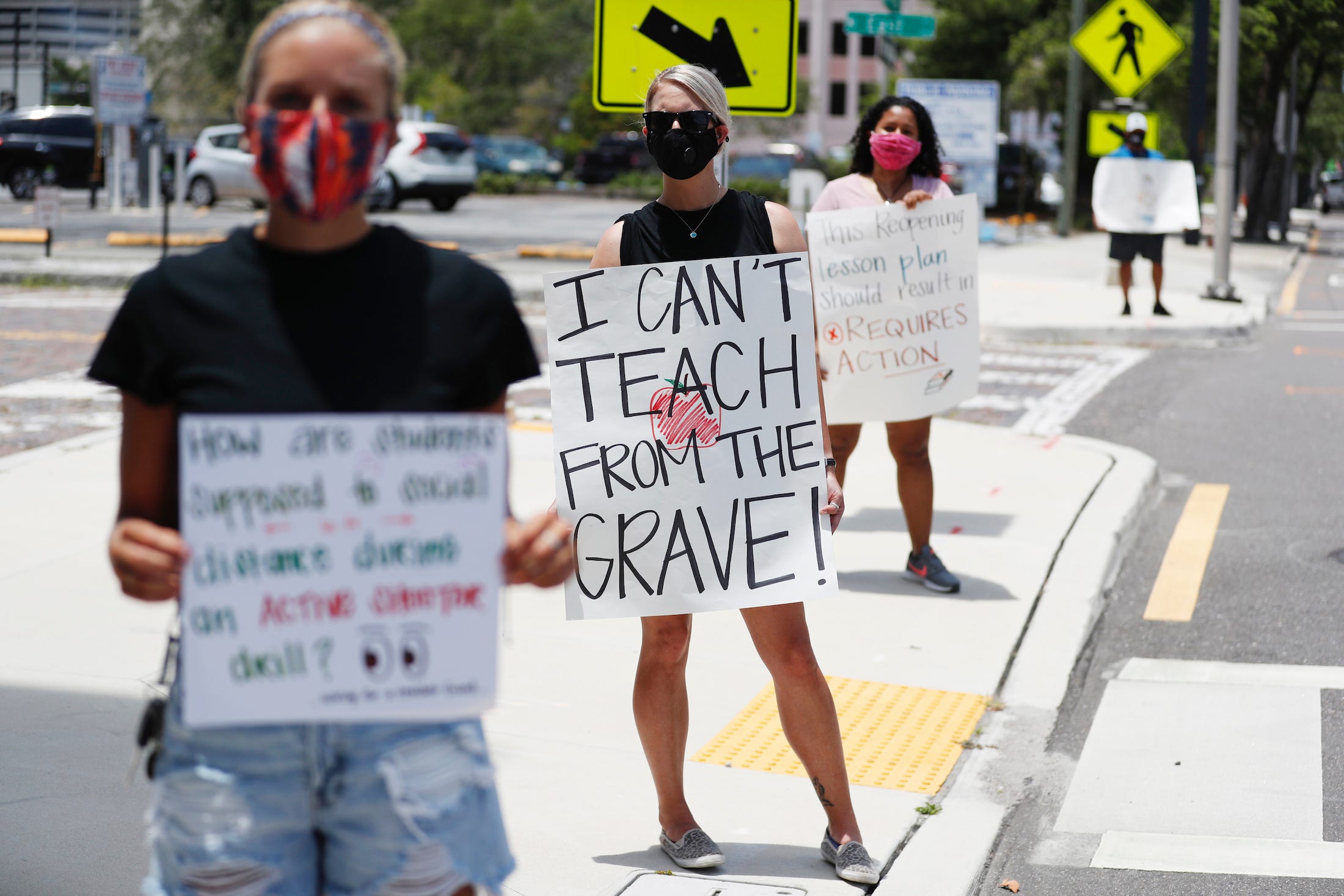- Teachers, students, and parents across the US are overwhelmingly concerned about going back to packed classrooms this fall, with the novel coronavirus still on the loose.
- President Donald Trump has been bullish about reopening schools to in-person classes, even as experts warn that is a very risky move.
- But there are many things that could be done to make classes safer, including holding them outside, insisting on masks, and keeping a good distance between students. These moves are already being tried out in other places around the world.
- Visit Business Insider’s homepage for more stories.
Teachers, parents, and students across the US are worried about returning to packed classrooms this fall, as the coronavirus continues to spread rapidly across America.
The nation’s largest school district in New York City is already preparing for a “blended” system of in-classroom and at-home learning in the fall. In Los Angeles, where coronavirus cases are surging, the district will be online-only when school resumes this August. And in Florida, teachers are suing the state over its plan to reopen schools fully next month, even while coronavirus cases are still soaring there.
“What we want to do is we want to get our schools open,” President Donald Trump said on July 7. “We want to get them open quickly, beautifully in the fall.”
But disease experts in the federal government maintain that holding traditional, full-size, in-person classes where students are not spaced apart during the pandemic is a very risky move.
Complicating matters further, roughly one in five teachers across the US is over the age of 55, making them at high risk for dangerous coronavirus complications, if they were to contract the virus at school.
"I am urging all schools to open, and to be providing their students a full-time education," Education Secretary Betsy DeVos told CNN on July 12, echoing President Trump. "The go-to needs to be kids in school, in person, in the classroom."
The truth, though, is that going back to school this fall does not have to be such an all-or-nothing, jam-packed indoor classrooms versus distance learning proposition.
Here are just a few of the creative, and often low-cost ways that students and teachers around the world - and through the ages - have been holding classes, while keeping infectious diseases at bay:
The virus does not spread well outdoors, and many schools around the world are already using that knowledge to their advantage.

"Outdoors, there's infinite dilution ventilation," Dr. Don Milton, a virologist and environmental health professor at the University of Maryland, who studies how people catch and transmit viruses, previously told Business Insider.
Crowded, stuffy places, like fully-packed classrooms and indoor bars can be great places for the coronavirus to spread.

Keeping your distance, even when outside, helps avoid spreading the virus, as these kids in Cyprus seem to know.
Primary schools in Italy are already experimenting with outdoor, socially distanced classes for kids.

It's still unclear how well kids transmit the coronavirus to others.
It's a lot like a strategy that was once successfully implemented in the US, to prevent the spread of tuberculosis in the early 1900s.

Kids in chilly Chicago and New York avoided catching that respiratory pathogen by getting out into fresh, cold air, as the Chicago Tribune and New York Times recently reported.
It's tougher for wayward coughs, shouts, and sneezes to spread infections through fresh air outside.

But open-air schools may definitely require some bundling up in the winter time, and overhead protection from rain or snow.
Relatively few studies have attempted to answer the question of whether outdoor instruction is inherently better than learning inside.

But scientists have long said that being out in greenery is good for our mood, even if researchers aren't sure, yet, if learning to do your math outside is really much different than multiplying numbers indoors.
Outdoor, exploratory school days in Denmark, called udeskole, have shown some promise helping kids develop their own scientific inquiry skills, and (as a bonus) they keep students more physically active throughout the day.
In Thailand, classrooms like this one appear to be hip to the idea that keeping the windows open to circulate fresh air is another smart antiviral move.

Other good practices for virus control you can see at work in this classroom include having the desks spaced apart, and wearing masks.
"It's not one thing; it's not just about the issue of masks, or it's not just about the issue of hand-washing ... It is a combination of measures," the World Health Organization recently said.

"We don't know what the perfect combination is of interventions," the WHO's executive director of health emergencies, Mike Ryan, said on Friday,
"What we do know is if individuals and communities are very aware of those risks, very aware of the virus transmission in the area, if the authorities are taking action to ensure that people are safe, safe in schools, safe in restaurants, safe in buildings, and if all of that comes together in an organised and understandable way for communities in the main - those countries, those areas, control this virus."
In the Kashmir Valley, these students are practicing social distancing, wearing masks, and getting fresh air, all while learning some math.

"I first tried teaching online," their teacher, Muneer Alam told The Indian Express. "But on 2G internet, it was near impossible."
Masks are required attire in this outdoor class, and there's also a "no mingling" allowed policy.

Alam's teaching his math course on a pay-what-you-can scale amid the pandemic, when so many people are out of work.
"Education is very important in a place like Kashmir," Alam said. "It's the only way to keep our youth away from depression, drugs, or violence."











